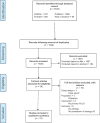Pelviureteric junction obstruction in adults: A systematic review of the literature
- PMID: 37691990
- PMCID: PMC10489243
- DOI: 10.1097/CU9.0000000000000154
Pelviureteric junction obstruction in adults: A systematic review of the literature
Abstract
Background: Pelviureteric junction obstruction (PUJO) is a common urological disorder that can present at any stage of life. The underlying etiology in children has been well studied; however, a gap exists in the literature for the adult population. Herein, we performed a systematic review of the literature to evaluate the current evidence on the underlying etiologies of adult patients presenting with PUJO.
Materials and methods: Four electronic databases were searched for relevant studies assessing the underlying etiologies of pelviureteric junction obstruction in adults. Studies were assessed for eligibility based on predefined inclusion and exclusion criteria, and a critical appraisal of methodological quality and risk of bias was performed. Finally, qualitative and quantitative data analyses were performed.
Results: Twelve studies comprising a total of 513 patients with radiologically confirmed PUJO met the inclusion criteria and were included in our analysis. The most common finding was crossing vessels, which were observed in 50.5% of patients, followed by intrinsic ureteral stenosis (27.1%), adhesions (15.3%), and high insertion of the ureter (10.1%).
Conclusions: The underlying etiologies of PUJO in adults remain unclear. This study indicated that obstruction secondary to crossing vessels is the most common cause of obstruction in adults and occurs more frequently than in the pediatric population.
Keywords: Adults; Etiology; Pelviureteric junction obstruction; Ureteropelvic junction obstruction.
Copyright © 2022 The Authors. Published by Wolters Kluwer Health, Inc.
Conflict of interest statement
2.1. Study design and search strategyThis study comprised a systematic review of both observational and experimental trials and was conducted in accordance with the PRISMA (Preferred Reporting Items for Systematic Reviews and Meta-Analyses) reporting guidelines. The following search terms were used to identify relevant studies: “ureteropelvic* junction obstruction,” “pelviureteric* junction obstruction,” “etiolog*,” “etiology*,” “adult.” The EMBASE, MEDLINE, Web of Science, and CINAHL were searched in March 2021. Gray literature was also searched to further identify ongoing research. Finally, the references of all articles satisfying the inclusion criteria were analyzed to identify potentially relevant studies not detected in the online search.2.2. Study selectionA database was created using the reference management software Endnote X9™ (Clarivate, UK). Two researchers independently reviewed the outputs from the searches. After removing duplicates, studies were independently screened for eligibility by both authors. Discrepancies were discussed until consensus was reached. Eligibility was assessed using the predetermined inclusion and exclusion criteria, described below. A summary of the screening process is shown in the PRISMA flow diagram (Fig. 1).2.3. Eligibility criteriaOriginal studies on radiologically confirmed PUJO in adult patients were included in the initial screening process. Studies with no documented etiology were excluded, as well as individual case reports. For studies that included both pediatric and adult patients, only data from adult patients were included in the review.2.4. Quality assessment and data analysisA critical appraisal of the methodological quality and risk of bias of the included studies was performed using the Newcastle Ottawa Scale.[13] For the included studies that did not report outcomes in a manner that enabled us to extract the data for inclusion in this review, the authors were contacted, and the raw data were requested. The primary outcome was the underlying cause of obstruction. Secondary outcomes included the radiological method of diagnosis, treatment modalities used, and success rate following treatment.2.5. Ethics and data protectionEthical approval and informed consent were not obtained. The anonymized raw data were encrypted and stored on a password- protected computer. The authors declare that they have no conflicts of interest in relation to this work.Ethical approval and informed consent were not obtained. The anonymized raw data were encrypted and stored on a password- protected computer. The authors declare that they have no conflicts of interest in relation to this work.No conflict of interest has been declared by the author.
Figures
References
-
- Al Aaraj MS, Badreldin AM. Ureteropelvic Junction Obstruction. Treasure Island: StatPearls Publishing; 2022. - PubMed
-
- Williams B, Tareen B, Resnick MI. Pathophysiology and treatment of ureteropelvic junction obstruction. Curr Urol Rep 2007;8(2):111–117. - PubMed
-
- Castaneda F, Hernandez-Graulau JM. Percutaneous endopyelotomy for the treatment of ureteropelvic junction obstruction. Semin Intervent Radiol 1996;13(2):169–183.
LinkOut - more resources
Full Text Sources
Miscellaneous

